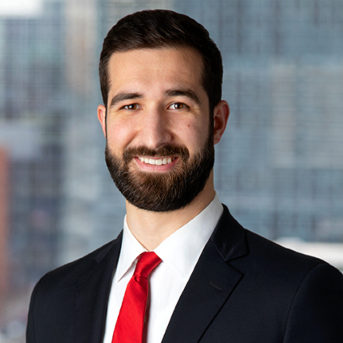“After the per curium panel opinion in LKQ, obviousness for design patents continues with business as usual. But change may be on the horizon.”
 Just like utility patents, design patents can be found obvious under 35 U.S.C. § 103 by combining prior art references. But the test for obviousness for design patents differs from the more familiar standards for utility patents. The U.S. Court of Appeals for the Federal Circuit recently reaffirmed this distinction, but the issue is far from resolved. A long line of Patent Trial and Appeal Board (PTAB) actions between LKQ and GM Global Technologies escalated to the Federal Circuit, where LKQ submitted an argument seeking to fundamentally change the obviousness analysis for design patents. Like all previous PTAB actions between the parties, PGR2020-00055 started with LKQ’s challenge to GM’s design patent for a vehicle body panel – this time a “vehicle front skid bar.” (PGR2020-00055 Petition at Cover). The PTAB applied the design-patent-specific obviousness test announced in In re Rosen and Durling v. Spectrum Furniture Co. to find that the claims were not obvious. On appeal, LKQ argued that the Supreme Court overruled the Rosen/Durling test in its KSR v. Teleflex decision. (LKQ Corp. v. GM Global Technology Operations LLC, 2023 WL 330605 (2023) (No. 2022-1253) at *3). While the Federal Circuit avoided the issue by stating it could not “overrule Rosen or Durling without a clear directive from the Supreme Court,” the opinion and concurrence signaled a potential lack of appetite for the challenge, prompting LKQ to submit a petition for rehearing en banc. That petition expressly asks to change the law. (Appellants’ Request for Rehearing en banc, LKQ Corp. v. GM Global Technology Operations LLC, 2023 WL 330605 (2023) (No. 2022-1253)).
Just like utility patents, design patents can be found obvious under 35 U.S.C. § 103 by combining prior art references. But the test for obviousness for design patents differs from the more familiar standards for utility patents. The U.S. Court of Appeals for the Federal Circuit recently reaffirmed this distinction, but the issue is far from resolved. A long line of Patent Trial and Appeal Board (PTAB) actions between LKQ and GM Global Technologies escalated to the Federal Circuit, where LKQ submitted an argument seeking to fundamentally change the obviousness analysis for design patents. Like all previous PTAB actions between the parties, PGR2020-00055 started with LKQ’s challenge to GM’s design patent for a vehicle body panel – this time a “vehicle front skid bar.” (PGR2020-00055 Petition at Cover). The PTAB applied the design-patent-specific obviousness test announced in In re Rosen and Durling v. Spectrum Furniture Co. to find that the claims were not obvious. On appeal, LKQ argued that the Supreme Court overruled the Rosen/Durling test in its KSR v. Teleflex decision. (LKQ Corp. v. GM Global Technology Operations LLC, 2023 WL 330605 (2023) (No. 2022-1253) at *3). While the Federal Circuit avoided the issue by stating it could not “overrule Rosen or Durling without a clear directive from the Supreme Court,” the opinion and concurrence signaled a potential lack of appetite for the challenge, prompting LKQ to submit a petition for rehearing en banc. That petition expressly asks to change the law. (Appellants’ Request for Rehearing en banc, LKQ Corp. v. GM Global Technology Operations LLC, 2023 WL 330605 (2023) (No. 2022-1253)).
Such a change could have a significant impact on post-consumer markets. Design patents provide powerful protection to car manufacturers hoping to prevent third parties from selling replacement body panels for their vehicles. Two factors make vehicle body panels uniquely well-positioned to benefit from design patent protection: first, customers want the replacement to look the same as the original, maintaining symmetry and the vehicle’s factory appearance; and second, post-collision repairs are often paid for by insurance, meaning the increased cost of paying for OEM panels is not readily apparent to customers. By obtaining design patent coverage on individual body panels, vehicle manufacturers protect a valuable income stream for years after the original vehicle sale. It is unsurprising that the recent challenge to design patent obviousness standards originated from a dispute between an OEM and a third-party panel manufacturer over the design patent preventing the third party from selling replacement panels.
Rosen and KSR: Dueling Standards?
In re Rosen articulated a first step in the design patent obviousness analysis. (673 F.2d 388 (C.C.P.A., 1982)).). Under Rosen, courts first identify a primary reference, “something in existence, the design characteristics of which are basically the same as the claimed design.” (Id. at 391). In other words, the court must find that the prior art reference is sufficiently similar to the challenged design patent for that reference even to be considered in the obviousness analysis. Durling added a second step to the analysis. (Durling v. Spectrum Furniture Co., 101 F.3d 100, 103 (Fed. Cir., 1996)). Once a reference that is “basically the same” as the claimed design is identified, the court then considers whether the primary (or Rosen) reference can be modified, based on other prior art, to create a design with “the same overall visual appearance as the claimed design.” (Id).
When it rejected “rigid and mandatory formulas” for patent obviousness, the KSR Court was not considering design patents. (KSR Int’l Co. v. Teleflex Inc., 550 U.S. 398, 419 (2007)). The patent at issue in KSR was a utility patent and the Supreme Court’s opinion contains no direct discussion of design patents. In the 15 years since KSR, the Federal Circuit heard only one challenge to Rosen on KSR grounds. In Titan Tire Corp. v. Case New Holland, the Federal Circuit ducked the question. (566 F.3d 1372, 1384-85 (Fed. Cir. 2009)). It called “the application of KSR to design patents … ‘new and untested ground,’” and stated “it is not obvious that the Supreme Court necessarily intended to exclude design patents from the reach of KSR.” (Id).
LKQ and the Rosen Challenge
LKQ’s appeal squarely placed the KSR-based challenge to the Rosen/Durling test back in the Federal Circuit’s sights. LKQ argued that KSR implicitly overrules the Rosen/Durling test because Rosen’s primary reference requirement “would run afoul of KSR’s proscription against rigid restrictions on the scope of an obviousness analysis.” (LKQ Corp. v. GM Global Technology Operations LLC, No. 2022-1253 at *4 (citing LKQ’s petition to the Board)). Arguing for LKQ, Mr. Mark Lemley asserted “the correct test should be the KSR test applied through the filter of the designer of ordinary skill in the art.” (Oral Argument at 9:55-10:02, LKQ Corp. v. GM Global Technology Operations LLC, No. 2022-1253). GM countered, characterizing LKQ’s position as “an overstatement of the holding of KSR and the parameters of Rosen.” (Id. at 14:12-18).
As in Titan Tire, the Federal Circuit did not reach the substance of LKQ’s challenge to Rosen, stating that it could not overrule the existing Rosen/Durling law without direction from the Supreme Court and affirming the Board’s holding that LKQ failed to show the challenged patent would have been obvious per curium. LKQ Corp. v. GM Global Technology Operations LLC, No. 2022-1253 at *5 (“We, as a panel, cannot overrule Rosen or Durling without a clear directive from the Supreme Court. … The panel is therefore bound to apply existing law to this appeal”)). In this opinion the panel hinted at a lack of appetite for the challenge, stating “KSR did not involve or discuss design patents,” and “in the fifteen years since KSR was decided … this court has continually applied Rosen and Durling, just as it had in the decades proceeding.” (Id).
Both Judge Lourie and Judge Stark wrote separately to express additional views. While Judge Stark recognized that there is “substantial tension between the Supreme Court’s holding in KSR and [the] Durling test,” both made clear that they did not think KSR overruled Durling. Judge Lourie’s concurrence articulates three bases for his view. (LKQ Corp. v. GM Global Technology Operations LLC, No. 2022-1253 at *6 (Lourie, J., concurring)). First, KSR did not involve design patents. (Id. at 7). Judge Lourie asserted this is critical because the considerations involved in determining obviousness for design patents differ from those involved in determining obviousness for utility patents. (Id). Second, even if Rosen overstated its point by adding the “basically the same” requirement to the primary reference, it is hardly reflective of the overly rigid test KSR condemned. (Id). Lastly, Rosen was not essentially incorrect because a starting point is necessary to determine what a design is obvious over. (Id).
LKQ responds to Judge Lourie’s position in their en banc petition. LKQ argues that “the Patent Act plainly applies the same §103 to design patents.” (Appellants’ Request for Rehearing en banc at 15, LKQ Corp. v. GM Global Technology Operations LLC, 2023 WL 330605 (2023) (No. 2022-1253)). Therefore, even if the considerations for utility patent obviousness differ from those of design patent obviousness, they would in no way indicate a more rigid rule is appropriate for design patents. (Id).
Practical Effects
After the per curium panel opinion in LKQ, obviousness for design patents continues with business as usual. But change may be on the horizon. LKQ filed a request for rehearing en banc, focusing solely on the issue of Rosen’s potential overruling in light of KSR. As summarized by Mr. Lemley: “we don’t say ‘let’s just start with one reference,’ right, instead what we say is ‘what would a person of skill in this field actually do.’” (Oral Argument at 2:25-32, LKQ Corp. v. GM Global Technology Operations LLC, No. 2022-1253). While a panel cannot overrule existing law, the en banc Federal Circuit can.
The petition has already garnered significant interest, with three amicus briefs filed to date in support of LKQ’s position. (See Corrected Brief of Amici Curiae American Property Casualty Insurance Association and National Association of Mutual Insurance Companies ISO Rehearing en banc, No. 2022-1253, D.I. 68; Brief of Amici Curiae Intellectual Property Law Professors ISO Request for Rehearing en banc, No. 2022-1253, D.I. 69; TYC Brother Industrial Co., Ltd and TYC Americas’ Amici Curiae Brief ISO Appellant’s Request for Rehearing en Banc, No. 2022-1253, D.I. 66). For example, the National Association of Mutual Insurance Companies’ amicus brief cited NAMIC’s “significant interest in a robust and competitive market for insured auto repair,” (Corrected Brief of Amici Curiae American Property Casualty Insurance Association and National Association of Mutual Insurance Companies ISO Rehearing en banc, No. 2022-1253, D.I. 68 at 2) and argued that the Rosen test “creates an anti-competitive landscape.” (Corrected Brief of Amici Curiae American Property Casualty Insurance Association and National Association of Mutual Insurance Companies ISO Rehearing en banc, No. 2022-1253, D.I. 68 at 2). Another, filed by a group of law professors, reflects concerns “about the over-extension of protection based on conceptual mistakes.” (Brief of Amici Curiae Intellectual Property Law Professors ISO Request for Rehearing en banc, No. 2022-1253, D.I. 69 at 1). Likewise, TYC Bothers Industrial Co., a third-party manufacturer of replacement automotive parts, argued on policy grounds that the Rosen test “has the practical effect of unnecessarily stifling the aftermarket parts industry.” (TYC Brother Industrial Co., Ltd and TYC Americas’ Amici Curiae Brief ISO Appellant’s Request for Rehearing en Banc, No. 2022-1253, D.I. 66. at 4).
If Rosen is overturned, the practical effects are difficult to ignore. As Judge Lourie pointed out, Rosen simply answers the preliminary question, “obvious over what.” (LKQ Corp. v. GM Global Technology Operations LLC, No. 2022-1253 at *7 (Lourie, J., concurring)). Without a single starting point, design patents may be easier to invalidate. According to Professor Sarah Burstein, an expert in design patent jurisprudence, “[u]nmooring the § 103 inquiry from this primary reference requirement would allow challengers to pick and choose visual elements from the prior art to combine into ‘Frankenart.’” LKQ’s en banc petition acknowledges this issue, but states, “[d]esign patent obviousness is and will continue to be bounded by the practices of ordinary designers.” (Appellants’ Request for Rehearing en banc at 14, LKQ Corp. v. GM Global Technology Operations LLC, 2023 WL 330605 (2023) (No. 2022-1253)). Moreover, utility patents deal with “Frankenart” all the time, with some parties advancing combinations of five or more references to allegedly invalidate a single claim.
But LKQ’s position does not answer practical questions about what the change would mean. It does not, and perhaps cannot, explain how KSR’s test practically bounds the analysis. Open questions remain: what is “teaching” when design patents consider “overall appearance, visual impressions, artistry, and style,” rather than utility and function? (LKQ Corp. v. GM Global Technology Operations LLC, No. 2022-1253 at *7 (Lourie, J., concurring)). Where does “motivation to combine” come from, where design patents lack a written specification? And what is the level of skill of an ordinary designer?
If the Federal Circuit accepts LKQ’s position, the design patent obviousness analysis will likely receive new guidance, regardless of the outcome. If that new guidance issues, it is possible that application of KSR to design patents could impact the utility patent jurisprudence. Even if the Federal Circuit upholds Rosen, it may provide further guidance on how courts consider obviousness of “ornamental subject matter.” (Id). Accordingly, unless LKQ’s petition is rejected, the boundaries of design patent obviousness are likely to be either clarified or expanded, very soon.
Image Source: Deposit Photos
Image ID: 134115992
Author: ionutparvu

![[IPWatchdog Logo]](https://ipwatchdog.com/wp-content/themes/IPWatchdog%20-%202023/assets/images/temp/logo-small@2x.png)



![[Advertisement]](https://ipwatchdog.com/wp-content/uploads/2024/04/UnitedLex-May-2-2024-sidebar-700x500-1.jpg)
![[Advertisement]](https://ipwatchdog.com/wp-content/uploads/2024/04/Artificial-Intelligence-2024-REPLAY-sidebar-700x500-corrected.jpg)
![[Advertisement]](https://ipwatchdog.com/wp-content/uploads/2024/04/Patent-Litigation-Masters-2024-sidebar-700x500-1.jpg)

![[Advertisement]](https://ipwatchdog.com/wp-content/uploads/2021/12/WEBINAR-336-x-280-px.png)
![[Advertisement]](https://ipwatchdog.com/wp-content/uploads/2021/12/2021-Patent-Practice-on-Demand-recorded-Feb-2021-336-x-280.jpg)
![[Advertisement]](https://ipwatchdog.com/wp-content/uploads/2021/12/Ad-4-The-Invent-Patent-System™.png)






Join the Discussion
2 comments so far.
Anon
May 16, 2023 03:27 pmIf we are going to presume utility patent case law, how does the 103 (for design patents) stand in view of analogous art and the recent (but aging) In re Surgisil?
If for designs, “analogous” is constrained per item to be ornamented (and if elsewise, the prohibition of ‘design in abstract appears to be violated), could KSR make up that legal distance?
Sarah Burstein
May 16, 2023 09:55 amHi – Thanks for the mention but you seem to have misunderstood my post. My point was that the Frankenart approach isn’t appropriate for design patents *because of* the fundamental differences between design patent and utility patent claims. So saying “well, we do this in utility patents” isn’t actually a refutation of my argument.